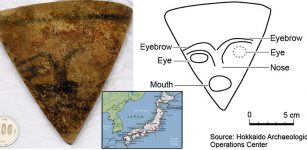Ancient Nanotechnology Knowledge Inspired A Modern 3D-Printable ‘Lycurgus Cup’
Conny Waters - AncientPages.com - The magnificent Lycurgus cup is a stunning ancient artifact that offers evidence our ancestors were familiar with nanotechnology.
Nowadays it’s no secret that people of the past were much smarter than we previously thought, but this ancient object, currently kept at the British Museum is very valuable because it’s the only surviving complete example made from dichroic glass, which changes color when held up to the light.
Lycurgus cup, variations of color. Image credit: British Museum
As previously discussed on Ancient Pages, “knowledge about metallic nanoparticles have already been used since ancient times, especially regarding the unusual colors seen in the ancient glass and ceramic objects. It is believed that the use of metallic nanoparticles started with the beginning of glass-making in Egypt and Mesopotamia that dates back in the fourteenth and thirteenth centuries BC.
The most remarkable example of the use of metallic nanoparticles is Lycurgus Cup, a piece of Roman glasswork dating from the fourth century CE, showing a mythological scene depicting the legend of King Lycurgus.”
Modern scientists from the Wageningen University and Research in the Netherlands, have now taken advantage of our ancestors’ knowledge about nanotechnology and produced a fantastic 3D-printed cup that changes color. The cup is dichroic, which means it reflects color depending on the light conditions. It can be either purple or brown.
Humans have always been fascinated by colors. The color blue, for example have captivated ancient civilizations. The Egyptian blue, the world’s oldest artificial pigment has extraordinary properties and will enable us not only to reconstruct the past, but also possibly to shape the technological future. Not long ago scientists announced they discovered ancient Egyptian blue powder makes fingerprints glow and will be used by crime scene investigators.
The Egyptian blue is world's oldest artificial pigment. Read more
The Maya were also familiar with artificial pigments. The Maya Blue has been a scientific puzzle mainly due to its unusual chemical composition. Maya blue is an extremely resistant artificial pigment. Despite time and the harsh weathering conditions, paintings colored by Maya blue have not faded over time.
See also:
Flexible Glass – Lost Ancient Roman Invention Because Glassmaker Was Beheaded By Emperor Tiberius
Hypocaust – First Central Heating Invented By Ancient Romans 2,000 Years Ago
There are many examples showing ancient people used colors in a variety of ways. The use of colors depended on the time period. Prehistoric painters decorated the caves’ walls using earth pigment. Later, ancient people discovered that color that came from iron oxide deposits in the earth would not fade with the changing environment. Our ancestors experimented with colors and more sophisticated technology soon emerged.
As Vittorio Saggiomo and his colleagues explain, “copper nanoparticles, for example, have been found in red glass from the late Bronze Age, 1200–1000 BCE. The use of nanoparticles as a colorant boomed around the 4th century CE within the Roman empire, where craftsmen, unaware of the existence of surface plasmon resonance, used metallic nanoparticles for coloring mosaic tiles, pottery and glass.”
This color-shifting 3-D printable cup was inspired by the ancient Lycurgus cup. Credit: Vittorio Saggiomo
To create this color-shifting cup, Saggiomo and his team used gold nanoparticles and a 3D-printable clear plastic. The nanoparticles were mixed citrate, a weak organic acid that occurs naturally in citrus fruits. After a while, the plastic dissolved in the liquid. When it had dried out, researchers produced the 3-D printed shape.
Scientists understood the cup couldn’t be used for drinking water as it will dissolve after a few minutes. To fix this, they “coated the 3D-printed cup with a layer of polydimethylsiloxane (PDMS), a flexible, nontoxic and food-safe transparent elastomer”. The end results were astonishing. The cup was now able to withstand water without any leakage, but of course it isn’t really practical for drinking. Producing such a cup isn’t expensive. Plastic and 3-D printing machine are available to most, and the cup’s gold atoms is only 0.07 per cent.
Researchers explain this technology “can be used not only by artists, but also for studying the optical properties of nanoparticles or, for example, for the 3D fabrication of optical filters.”
Written by Conny Waters – AncientPages.com Staff Writer
Copyright © AncientPages.com All rights reserved. This material may not be published, broadcast, rewritten or redistributed in whole or part without the express written permission of AncientPages.com
Expand for referencesKool, L.; Bunschoten, A.; Velders, A. H.; Saggiomo, V. Beilstein J. Nanotechnol. 2019, 10, 442–447. doi:10.3762/bjnano.10.43
More From Ancient Pages
-
 Underwater Robot Investigates Edo Period Decorative Tiles Off Shizuoka, Japan
Archaeology | Dec 7, 2015
Underwater Robot Investigates Edo Period Decorative Tiles Off Shizuoka, Japan
Archaeology | Dec 7, 2015 -
 Jomon Period: Triangle-Shaped Stone Artifact Depicting Human Face Found For The First Time In Japan
Archaeology | Dec 25, 2017
Jomon Period: Triangle-Shaped Stone Artifact Depicting Human Face Found For The First Time In Japan
Archaeology | Dec 25, 2017 -
 “Beowulf” – Old English Poem Was Probably Written By A Single Author – New Study
Archaeology | Apr 17, 2019
“Beowulf” – Old English Poem Was Probably Written By A Single Author – New Study
Archaeology | Apr 17, 2019 -
 Unique Female Viking Grave In Swedish Mountains Reveals Its Secrets
Archaeology | Jul 14, 2023
Unique Female Viking Grave In Swedish Mountains Reveals Its Secrets
Archaeology | Jul 14, 2023 -
 Ancient Reptilian-Like Humanoids Hold Secrets Of Mankind’s Origin
Ancient Mysteries | Apr 12, 2014
Ancient Reptilian-Like Humanoids Hold Secrets Of Mankind’s Origin
Ancient Mysteries | Apr 12, 2014 -
 Illuminati: Facts And History About The Secret Society
Featured Stories | Mar 30, 2017
Illuminati: Facts And History About The Secret Society
Featured Stories | Mar 30, 2017 -
 Bizarre Ancient Capuchin Crypt ‘Decorated’ With The Bones Of 4,000 Monks
Ancient Traditions And Customs | Nov 22, 2018
Bizarre Ancient Capuchin Crypt ‘Decorated’ With The Bones Of 4,000 Monks
Ancient Traditions And Customs | Nov 22, 2018 -
 Native American Tradition Of A Vision Quest – How To Enter The Spiritual World
Ancient Traditions And Customs | Apr 25, 2017
Native American Tradition Of A Vision Quest – How To Enter The Spiritual World
Ancient Traditions And Customs | Apr 25, 2017 -
 Oldest Yo-Yo Dates Back To 400-500 B.C
Ancient History Facts | May 13, 2019
Oldest Yo-Yo Dates Back To 400-500 B.C
Ancient History Facts | May 13, 2019 -
 Feud Between The Medici And The Borgia Families – What Caused The Renaissance Clash?
Featured Stories | Mar 5, 2019
Feud Between The Medici And The Borgia Families – What Caused The Renaissance Clash?
Featured Stories | Mar 5, 2019 -
 Mystery Of Dakhamunzu And The Zannanza Affair – Was Queen Ankhesenamun Hiding Her Identity?
Featured Stories | Feb 1, 2019
Mystery Of Dakhamunzu And The Zannanza Affair – Was Queen Ankhesenamun Hiding Her Identity?
Featured Stories | Feb 1, 2019 -
 Mysterious Ancient City Of Ebla That Existed Thousand Years Before Biblical Kings David And Solomon
Ancient Mysteries | Aug 14, 2015
Mysterious Ancient City Of Ebla That Existed Thousand Years Before Biblical Kings David And Solomon
Ancient Mysteries | Aug 14, 2015 -
 DNA From 10,000-Year-Old Scandinavian Chewing Gum Reveals Stone Age Diet
DNA | Jan 19, 2024
DNA From 10,000-Year-Old Scandinavian Chewing Gum Reveals Stone Age Diet
DNA | Jan 19, 2024 -
 Peculiar Neolithic Anomaly Investigated In Scotland
Featured Stories | Apr 27, 2024
Peculiar Neolithic Anomaly Investigated In Scotland
Featured Stories | Apr 27, 2024 -
 Mama Quilla – Incan Moon Goddess Of Marriage And Fertility Assisted By High Priestesses Of Qoricancha
Featured Stories | Jun 15, 2020
Mama Quilla – Incan Moon Goddess Of Marriage And Fertility Assisted By High Priestesses Of Qoricancha
Featured Stories | Jun 15, 2020 -
 DNA Of Nine 13th Century Crusaders Provides A Glimpse Into Soldiers’ Life And Death
Archaeology | Apr 22, 2019
DNA Of Nine 13th Century Crusaders Provides A Glimpse Into Soldiers’ Life And Death
Archaeology | Apr 22, 2019 -
 Ancient DNA Yields Surprising Findings On World’s Earliest Seafarers
Archaeology | Jun 30, 2022
Ancient DNA Yields Surprising Findings On World’s Earliest Seafarers
Archaeology | Jun 30, 2022 -
 Portus: History Of Ancient Roman Hub Of Commerce – Reconstructed With New Methods
Archaeology | Jul 17, 2019
Portus: History Of Ancient Roman Hub Of Commerce – Reconstructed With New Methods
Archaeology | Jul 17, 2019 -
 Australia’s Submerged Indigenous Sites – New Discoveries And Study
Archaeology | Aug 31, 2021
Australia’s Submerged Indigenous Sites – New Discoveries And Study
Archaeology | Aug 31, 2021 -
 Viking Treasures Discovered In Chamber Grave In Denmark
Archaeology | Apr 4, 2017
Viking Treasures Discovered In Chamber Grave In Denmark
Archaeology | Apr 4, 2017



